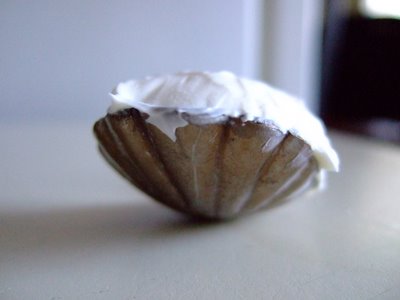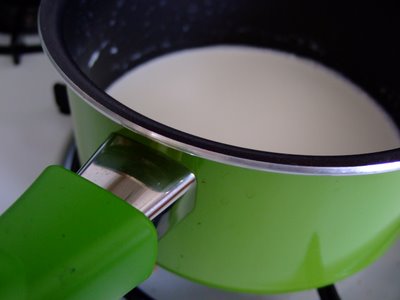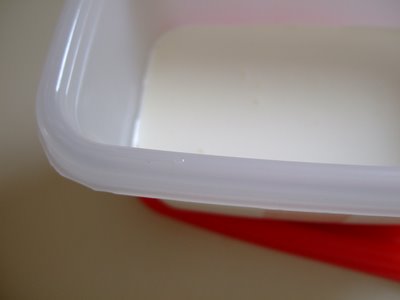Simple Crème Fraîche

I was super excited to be baking something for SHF. It would be my first event as a food blogger, and I had those first-day-of-school jitters as I prepped the recipe I had planned. Would it be edible? Would it look good? What were the other kids doing with their decorations?
As I began my foray into the event, it soon became clear that for me, the spolight was not going to be on my oh-so-cute mini cookies, but instead the crème fraîche. I had never made it before, and as a recent cross-country mover, I lack many standard kitchen appliances, utensils, and aids. What if I needed to do something incredibly high tech and convoluted to create this creamy, silky, nutty crème?
Rest assured, kitchenmates. Creating the crème fraîche is apparantly simple as encouraging the helpful bacteria to sour. After some poking around, a common recipe emerged: cream and buttermilk. I picked up both at the dairy, athrill with the idea of chemistry at work, and headed home to test this out.
My first roadblock was the innocuous labeling on my heavy whipping cream- the only whipping cream avaliable at the store. "Ultrapastuerized". No! Not ultra! The whole point was less pastuerization! Sometimes American dairy laws can be a bit on the frustrating side, eh? One site assured me that ultrapastuerized was okay, it just might take a little longer to set. It turns out that they were right- even without the extra time, ultrapastuerized was just fine.

In my research, I kept coming across two methods of thought for crafting crème fraîche; one was to warm the cream, then add the buttermilk. The other was to mix the two (without warming). I decided to test both methods and see which turned out the best. Several recipes also called for more buttermilk, while others called for less. I added a little extra to recipe #2, and also stored it in a plastic container with a lid (lid ajar) while recipe #1 was in a humble bowl, loosely covered with saran wrap. Then it was time to wait.
24 hours later, and it was clear there was an obvious winner. The cream and buttermilk I had combined without warming had thickened superbly, and was a lovely eggshell white in the plastic container. The other attempt however, refused to set even after additional hours were added to its time. It remained liquidy, with a runny layer on top. Dolloping my mini pumpkin cookies with the crème, I couldn't help but sneak a few bites. Later, I tried it in the tomato soup, and I am now plotting several winter soups with this addition. Until then, however, practice making simple crème fraîche on your own.
1 cup heavy cream (just pastuerized is best, but in a pinch, ultra-pasteurized will work)
2 Tablespoons buttermilk (I am inclined to think that 1 1/2 will work a bit better, but until I try that, I know for certain that 2 tablespoons works fine.)
Combine cream and buttermilk, and place in a glass jar, or small plastic containter. Set in a quiet area, at room temperature, and leave the lid slightly ajar. Let sit 24 hours, or until crème fraîche is thick. Once set, stir the crème fraîche, and refrigerate, up to 10 days.
2 Tablespoons buttermilk (I am inclined to think that 1 1/2 will work a bit better, but until I try that, I know for certain that 2 tablespoons works fine.)
Combine cream and buttermilk, and place in a glass jar, or small plastic containter. Set in a quiet area, at room temperature, and leave the lid slightly ajar. Let sit 24 hours, or until crème fraîche is thick. Once set, stir the crème fraîche, and refrigerate, up to 10 days.

Labels: Ingredients, Jams and Sauces


2 Comments:
you can actually buy raw cream although it is more difficult to come by. I see it from time to time at Cowgirl Creamer in the Ferry Buiding. I bet Rainbow stocks it too.
I absolutely need to visit Cowgirl Creamery. I hear so much about it, I'm sure to go dairy crazy once I do get up there.
Post a Comment
<< Home